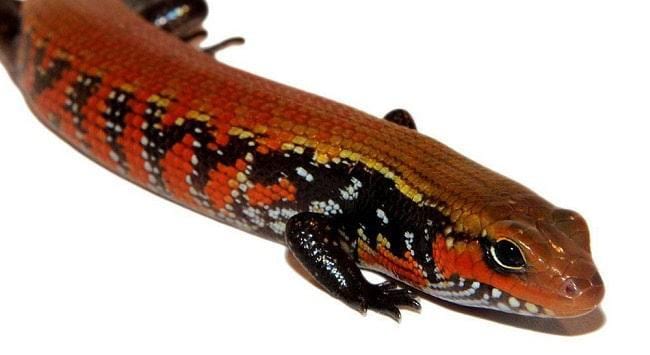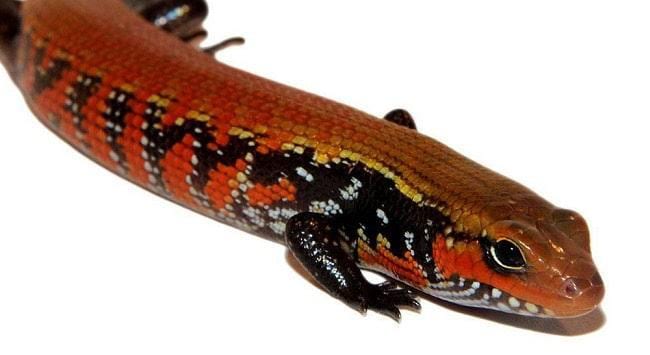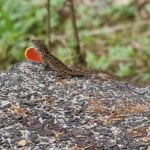Exotic pets have a reputation for being trickier than the normal kind of pet when it comes to what they need to stay healthy and to thrive as domesticated animals under captive care. After all, these animals were never meant to be kept under captive care as pets but have since found their own unique place in the homes of people who are now preferring to take care of exotic animals such as reptiles than the usual cat or dog you can find in most homes.
The African Fire Skink is one of those highly sought-after exotic pets that can be a bit tricky to handle. As a really popular choice for those who love taking care of pet reptiles, the African Fire Skink is not only a feast for the eyes but is said to be a very hardy and good companion as well. But you always have to consider the fact that these lizards have to be tamed first before you can get past its usual natural personality as a very shy animal. In that case, we have put together a guide that will help you take better care of the African Fire Skink so that you will be able to handle it really well as your next exotic pet.
What is the African Fire Skink?
General Information
The African Fire Skink is a species of skinks that is native to the continent of Africa. Their scientific name Lepidothyris fernandi was derived from one of their places of origin, the island that used to be called Fernando Po but is now named Bioko. They are much more common in a lot of countries in West Africa, where ball pythons are much more common as well. They can also be found in southern places such as Angola and in the eastern regions of Kenya. However, because of how popular these reptiles are, they have since been much more available as captive-breds rather than as wild-caught. Different owners all over the world prefer to have these lizards as pets because of their overall cuter appearance and their nature as reptiles that are not as dangerous or as difficult to handle as others are.
Physical Description

The African Fire Skink is said to be one of the most strikingly beautiful breeds of skinks or even reptiles to have as pets because of their vivid and stunning combination of colors. These lizards feature bodies that are adorned with an elegant bright red color that gives them that fiery look they are aptly named for. Black and white bars along the sides of the body of this reptile gives it a more dashing appearance. Meanwhile, they have backs that complete the overall elegance of this reptile as they usually sport backs that can be bronze or golden in color depending on the type of Fire Skink you have. Overall, just simply looking at the color combination that the African Fire Skink has already made it a really interesting pet as far as aesthetics are concerned.
While the African Fire Skink is not really a big lizard, it sports a main body that is quite large when compared in proportion to the rest of its body. The body tends to be long and squarish in shape. Meanwhile, they also have stout and round legs. Their tails give the typical appearance that most skinks have due to how thick they are. African Fire Skinks can grow up to 15 inches in length but start out as two-inch babies when they emerge from their eggs.
However, aside from its color and body shape, what really makes the African Fire Skink such a beloved pet reptile even for those who do not really prefer having reptiles around is that its overall features give it a cute appearance that can make anyone love it. This lizard really has an adorable look because of how its small face features big eyes while the rest of its body sports small limbs on what looks like a large and long body. In that regard, the African Fire Skink really looks like a feast for your eyes due to how it has an elegant color scheme that is coupled with its overall cute features.
Behavior
African Fire Skinks are known to be quite shy in the wild because of how they are small enough lizards to fall prey to larger animals. Some of their natural predators include snakes, larger lizards, big cats, and birds of prey. In that sense, wild African Fire Skinks are usually very reclusive and will most likely spend time hiding instead of staying out in the open where they can easily be hunted down by different types of predators
In terms of their sleeping habits, African Fire Skinks are actually diurnal animals that spend the day awake and active and the night resting or asleep. Despite being diurnal, it can still be difficult to spot them during the day because they prefer to keep themselves hidden from plain sight due to their shy and reclusive personality in the wild. It loves to burrow during the night when it is resting. During the day, it may still hide in burrows but will most likely hide in bushes, leaves, or under rocks.
Normally very shy animals in the wild, the African Fire Skink may display a bit of an outgoing nature when they are tame. Captive-breds are usually more outgoing than tamed wild-caught ones and are easier to handle due to how they are not as shy as their wild counterparts. However, wild-caught African Fire Skinks may still show a bit of an outgoing side once they get used to their captive lifestyle.
Eating Habits
African Fire Skinks are known to be carnivorous animals that almost exclusively eat meat or anything that is meat-based. In the wild, they will eat anything they believe they can dominate. As such, as long as the animal moves and is small enough for the African Fire Skink, this lizard will pounce on the opportunity to eat it. They like leaping towards their prey to pounce on it when given a chance to do, so as this allows them to make sure that they have the advantage over their prey.
Wherever these animals are, they tend to be voracious eaters that will try to eat anything they possibly can dominate. They are not choosy when it comes to their meals and will eat almost anything that is safe for them to eat. That is why these reptiles are not too difficult to feed when they are kept under captive care.
Safekeeping the African Fire Skink
Caging
When housing your African Fire Skink, it is important for you to make sure that it has enough horizontal space than vertical space. This reptile might be very adept at climbing, but they are much more active moving horizontally than vertically. As such, make sure you provide them a cage that is large enough for them. A 20-gallon tank might be good enough for one skink, but you may use a 40-gallon tank if you are housing two or three of these African Fire Skinks.
It is very important to decorate the African Fire Skink’s enclosure with things that can give it a natural feel. In that regard, you can place branches, plants, small trees, and anything similar inside the enclosure to add to the natural vibe. This can help improve the African Fire Skink’s overall health and can even give them a sense of security because they will be able to under rocks, branches, or large leaves. Branches also serve as perching spots for these lizards, although they are not the most active types of climbers.
The African Fire Skink thrives well on a substrate that also feels natural. Cypress mulch seems to be the better choice because of how well it holds moisture to improve humidity levels in the enclosure. Make sure that the substrate is deep enough and must be about six inches deep, at the very least, because of the African Fire Skink’s natural tendency to dig through the substrate to hide itself as a way of feeling safer.
Heating, Lighting, and Humidity
The African Fire Skink, as the name suggests, thrives well in an environment that is similar to what it naturally experiences in Africa. That means that you should keep its enclosure as warm as possible while also providing it with the humidity it needs to thrive well. The coolest temperature that the think can fall to should be about 75 degrees, but always make sure that the ambient temperatures are about 85 degrees Fahrenheit. Meanwhile, there should be a basking spot that is as hot as 92 to 96 degrees. You can provide the African Fire Skink with the heat and the light it needs by using reptile bulbs together with UVB lights.
Try to make sure that the enclosure is as humid as possible. Humidity levels should be about 60% but must not fall below 40%. The best way to keep the humidity levels consistent is to make sure that the substrate is as damp as possible. Mist the enclosure from time to time to improve humidity. You should also see to it that air can freely flow in and out of the enclosure by using a wire screen opening either at the front or at the top of the enclosure so that air can pass through quite easily.
Food and Water
The African Fire Skink is known to have an appetite that can be as ravenous as it can be. This voracious eater will not reject any sort of meal you offer it as it is actually one of the easiest animals to feed due to its nature of just gobbling up anything it sees as long as it can dominate its prey. As long as your African Fire Skink is healthy, it will not refuse a meal. If it refuses meals on a regular basis, then there might be something wrong with it.
When feeding the African Fire Skink, it is important to note that this reptile is a carnivorous eater. It will only feed on anything meat-based and will prefer to prey on insects. That means that it is better for you to use a variety of insects when feeding this reptile. Waxworms, mealworms, and crickets are good choices when you are looking for staple types of food to feed your African Fire Skink. However, make sure to minimize waxworms because they are higher in fat than mealworms and crickets are. You can also provide pinkie mice that have been thawed out because they provide a lot of calcium for your African Fire Skink.
Speaking of calcium, insects tend to be high in phosphorus and are low in calcium. In that sense, the one thing you should do is to dust the insects with a calcium supplement to improve the calcium intake of your African Fire Skink. You can also gut-feed the crickets with healthy greens to improve the overall nutrient intake of your pet reptile.
Since the African Fire Skink is a voracious eater, see to it that you stick to a strict feeding schedule to avoid overfeeding this animal. Take note that five to six insects are already enough for these reptiles. See to it that they only eat once every three days to minimize obesity. It is okay for your lizard to be full-bodied because a healthy African Fire Skink should look quite plump but not fat enough that they will tend to look more obese than stout.
Handling the African Fire Skink
It is not a secret that the African Fire Skink has a reputation for being a very shy and reclusive reptile that would almost always try to hide whenever it sees you. However, that is not always the truth. African Fire Skinks may be very shy in the wild, but there is no reason for them to still display the same kind of behavior when they are kept under captive care. There is a good chance that you may be able to tame an African Fire Skink and make it display a side that is outgoing.
Captive-bred African Fire Skinks are easier to tame than wild-caught ones. Nevertheless, give the skink some time to adjust to its environment and make it feel secure as much as possible. You may also want to have it associate you with food so that it will not be very shy whenever it sees you. When they are tame, African Fire Skinks will most likely be a bit excited to see their owner and will ask for food.
African Fire Skinks can be handled as long as they have adjusted to a captive lifestyle. Always make them feel secure when trying to handle them. They may be docile when you are handling them, but it can be difficult to secure them in your hands because of how squirmy they can be. In that sense, always handle them in a location that is safe so as to avoid any sort of injuries when they accidentally squirm out of your hands.



